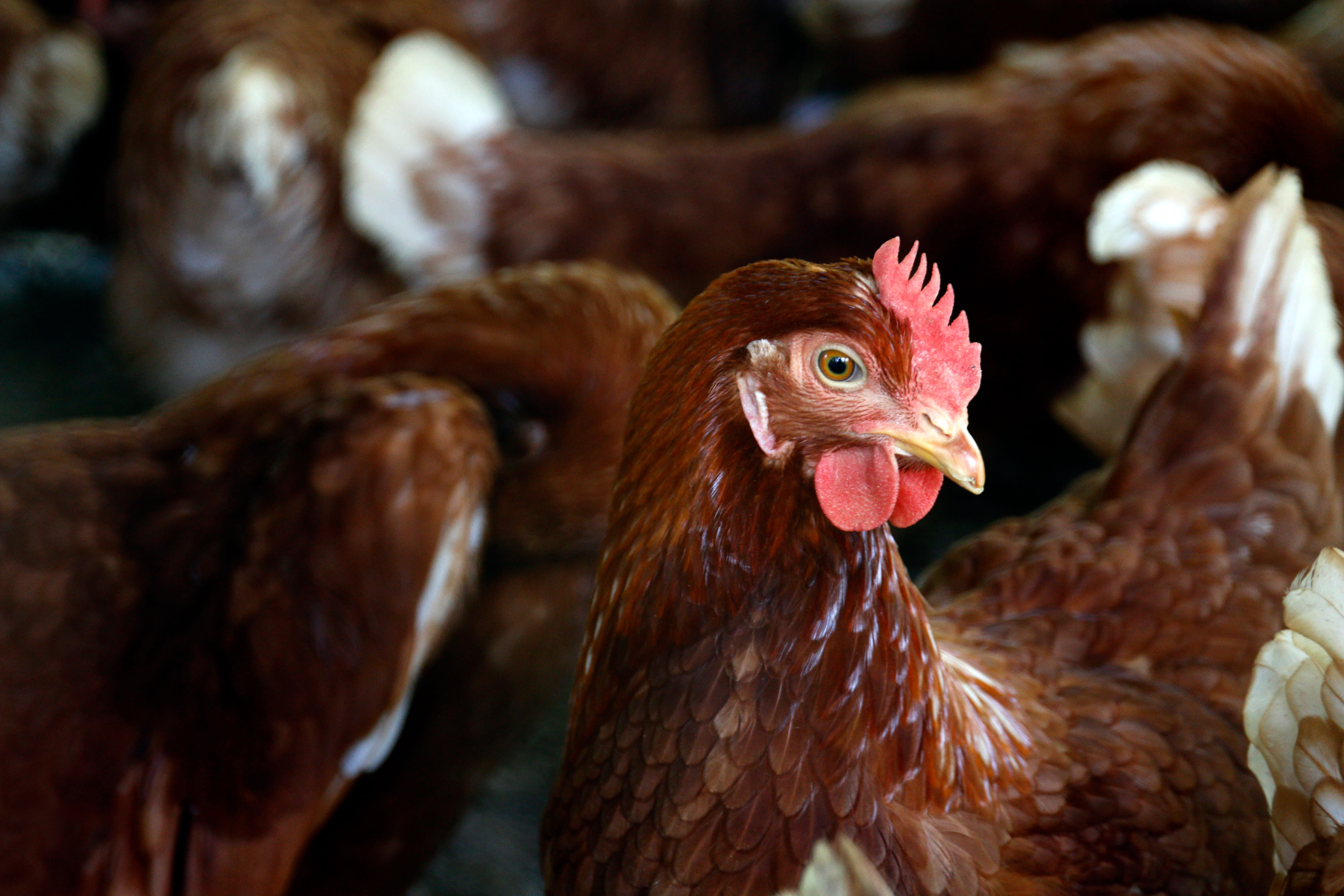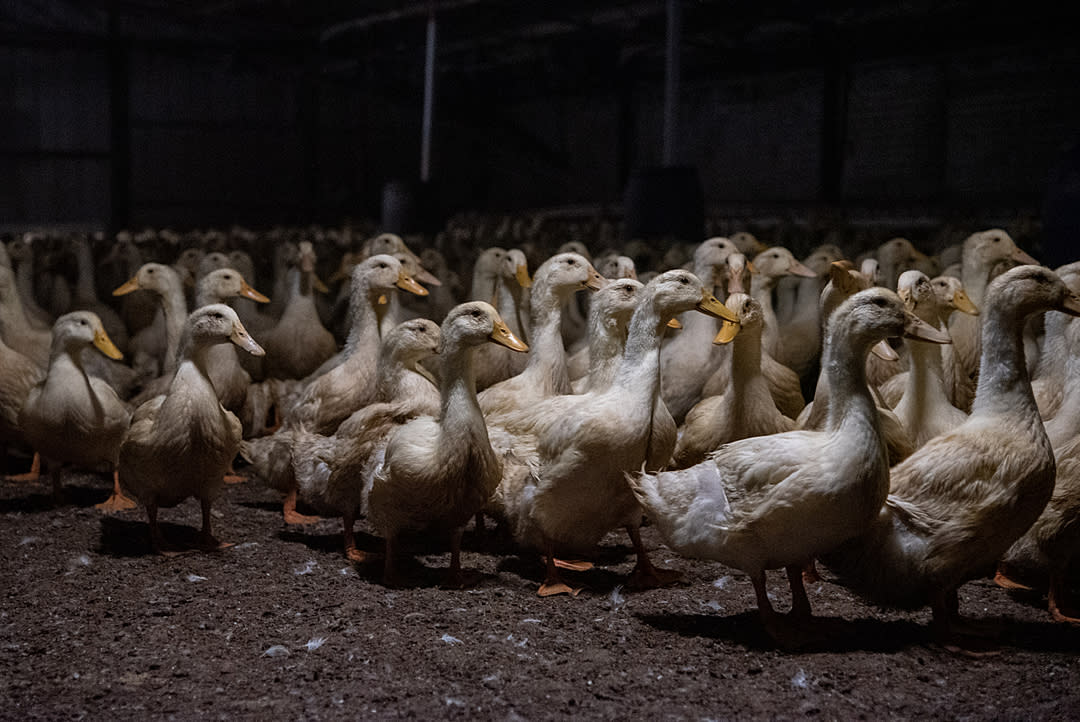




Chickens laying eggs have been part of human lives for centuries—they were domesticated over 7,000 years ago! But how does the egg production process actually work? And how has factory farming twisted a natural process?

For 7,000 years, humans and chickens have lived side by side. The egg production process has been part of the human experience across all those centuries. You might have had the chance to collect freshly laid eggs, but how much do you know about the process of egg production? How many eggs do chickens naturally lay? For how long can a chicken lay eggs? And how do factory farms threaten and abuse this natural process? It’s time to find out.
How do chickens lay eggs?
Chickens lay eggs as part of their reproductive cycle: after all, an egg is a baby chick’s first home! The chicken egg production cycle is much shorter than other animals’ gestation periods (including humans), and also much less painful.
In short, the cycle begins in a chicken’s ovary, where the yolk is created, and continues through a chicken’s oviduct, forming an egg white and shell, until it reaches her ovary. From there, the chicken pushes the egg through her vagina until it exits her body through her cloaca (also called a vent).
Not all eggs are automatically fertilized and therefore likely to hatch into a chick. A chicken often lays her eggs whether or not a rooster is present, so unfertilized eggs are common. Only if the hen is able to mate with a rooster will her eggs be fertilized and able to hatch into chicks.
The natural egg-laying cycle
While modern egg production often pushes chickens to lay unnaturally high numbers of eggs, understanding their natural cycle helps us appreciate these remarkable birds. In nature, wild chickens typically lay only 10-15 eggs each year. This slow rhythm allows hens to maintain their health and calcium reserves, unlike intensive farming practices that can deplete their bodies.
How long does it take for a chicken to lay an egg?
Believe it or not, this entire process of creating and laying an egg takes just 24 to 26 hours! It’s made up of several distinct stages, making the egg production process simple to understand.
Yolk release
An egg begins as a tiny ova, which develops into a yolk within the ovary. This process takes about half an hour. Then it moves into the first part of the oviduct, called the infundibulum, which is where the egg becomes fertilized if the hen has mated with a rooster.
Initial egg white is created
Now the egg travels further along the oviduct, into a section called the magnum. In the magnum, the egg white (also called the albumen) begins to form. Over three hours, the egg white will be about half formed and the egg can continue on its journey.
Egg shape is formed
The egg has now reached the isthmus, the final part of a chicken’s oviduct. Here, the egg white continues to develop while the first membranes of the inner and outer shell also start to form. This process takes an hour or two.
Eggshells are formed
The longest stage of the egg production process takes place now, in the chicken’s uterus. Here, the egg finishes developing its hard outer shell, until the chicken knows she is ready to lay! This stage takes from 20 to 21 hours.
Egg bloom is added and the egg emerges
In the last seconds of a chicken’s reproductive process, as the egg leaves her uterus and just before it exits her vent, the chicken adds a bloom to her egg: a layer or cuticle, which protects the egg from bacteria and ensures the interior of the egg stays moist. And then the chicken lays her egg! Again, this is a very short process, usually only taking a few minutes.
How long do chickens lay eggs?
Like humans, a chicken is born with all of the eggs she will ever have: thousands of ova waiting within her ovaries. Most hens begin to lay eggs when they are around six months old. Their ability to lay eggs depends upon the breed and individuality of each chicken: some hens will lay for five years, while others may continue to lay for as long as ten years. However, a chicken is likely to lay the most eggs over her first two years of laying.
What do people feed chickens?
Chickens are omnivores with a wide-ranging diet, and they may eat food as varied as:
- Clover and other grasses
- Grains and seeds
- Fresh fruit and vegetables (often appropriate food scraps from your kitchen table!)
- In small portions (as a treat), cooked food like rice, bread and pasta
- Small insects and worms
Chickens are natural foragers, who love exploring a wide area and looking for food wherever they can find it! But it’s important to keep a chicken’s diet balanced, as they need a healthy and nutritious mix of food, especially if they are laying eggs. So when people keep chickens as companions, they’ll often use chicken feed, whether commercially-produced or DIY. This feed comes in many varieties to offer the right mix of carbohydrates, protein, and vitamins to suit the chickens based on their breed, age, lifestyle, and more.
Another element to take into consideration when feeding chickens is grit. Grit has no nutritional value, but because chickens don’t have teeth, they need help grinding down their food and making it easy to digest. When a chicken eats grit, it is stored in her gizzard, where it works like teeth to mash her food into something digestible.
What do factory farms feed chickens?
The above diet is the ideal one for keeping backyard chickens happy and healthy. But factory farms don’t prioritize keeping chickens happy or healthy; their major concern is maximizing profit and egg production.
As a result, factory farms don’t allow chickens to forage: most chickens are kept in cages where they are unable to follow their natural feeding habits.
How do people increase chicken egg production?
Factory farms increase chicken egg production in a range of grim ways, including forced molting and selective breeding to produce unnaturally high amounts of eggs. This is all the more miserable because there are several ways to increase a chicken’s egg production without hurting her or her chicks. In fact, if a chicken is stressed or unhappy, she’s less likely to lay eggs, so it’s a practical tip to treat your chickens kindly! All the same, people use a range of processes to increase chicken egg production, some of which hurt chickens more than they help.
Breed
Some chicken breeds lay more than others. The breeds most known for laying include white leghorns, Sussexes, Goldline or hybrids, Plymouth Rocks, and Rhode Island Reds. Many of these chicken breeds are also known for being particularly friendly and fond of human companionship, like the Sussex and Goldline chickens.
Pullet management
During the first 18 weeks of a chick’s life, her body is developing fast. This includes growing and building the reserves for future laying. In the meat and egg industry, farms use a term called “pullet management” to ensure that chickens grow in a way that sets them up well to lay eggs. Pullet management aims to reach certain target body weights with high uniformity by understanding a chick’s development stages, providing her with enough space, regulating her temperatures, and feeding her fresh and balanced food.
Although pullet management emphasizes a chicken’s health, it also highlights a viewpoint which sees chickens as money-making objects, rather than living beings. Even the name “pullet” itself, referring to a young chick, is a step towards decentering her lived experience. And though pullet management is concerned with chicken health in some ways, in others it actively works against a chicken’s natural needs and happiness: most “pullets” grow up in dimly lit and crowded barns.
Light management for year-round production
Chickens need daylight! Light stimulates a chicken’s pituitary gland, which releases important hormones for her egg production cycle, and it also helps her skull, skin and feathers stay healthy. That means that naturally, chickens lay more eggs from spring onward, when daylight hours reach their peak, and less eggs as the night grows longer.
As a result, some farmers use artificial light to increase a chicken’s egg laying and make it so that she won’t stop laying eggs in the darker months. Managed carefully, artificial lighting might not hurt a chicken as long as she’s old enough—too much light causes a young chick to develop before her body is ready for the egg production cycle. When not managed carefully, artificial lighting can be harmful. And recent studies question whether artificial lighting is ever completely safe, indicating that it may lead to ovarian cancer and other reproductive issues.
Most importantly, as you’ve already learned, a chicken has a finite amount of eggs. Artificial light doesn’t create more eggs, it just means she’s more likely to lay all her eggs quickly and stop laying within a few years. Tragically, this is a technique often used by factory farms to get as much out of a hen as they can and then kill her when she is no longer useful to them.
Nutrition
A more positive change to help chickens lay more involves a balanced and healthy diet, as we’ve already discussed. Good nutrition for egg-laying chickens includes protein, calcium, and phosphorus.
Space
Chickens need at least three square feet per chicken in their coop alone, along with plenty of space to roam, forage, and explore during the day. Providing chickens with lots of space means they’ll be calm, happy, and usually well-fed, and therefore much more likely to lay eggs. When they don’t have enough space, chickens are much less likely to lay in the first place. They are also more likely to attack or harm their own or other chickens’ eggs.
How many eggs do chickens lay naturally?
It’s a sad fact that humans expect too many eggs from their chickens: in the wild, a chicken might lay only 10 to 12 eggs annually.
Though chickens who are bred to lay eggs or used to being domesticated lay more, the exact amount depends upon the chicken herself. Some chickens lay between 180 and 260 eggs a year, while egg-laying hybrid breeds lay more like 300 a year. A chicken’s happiness, comfort, diet, space, conditions, and temperament all affect how many eggs she will lay naturally.
Remember that the egg production process takes over 24 hours. For most chickens, expecting an egg a day is just unrealistic, and extremely taxing upon their bodies.
The future of egg production
The egg industry is experiencing significant technological and ethical transformations as consumers become more aware of animal welfare issues. A groundbreaking development came in December 2024 when US specialty egg producer NestFresh Eggs successfully implemented in-ovo sexing technology, which determines chick sex before hatching. This innovation could potentially spare 350 million male chicks from culling annually in the US alone.
How you can help chickens
Chickens love to lay eggs: it’s a natural part of their reproductive cycle. But under the exploitative demands of factory farming, chickens lay eggs in painful, miserable, and all-too-short timespans. Join us to work against the worst abuses of the egg industry!





